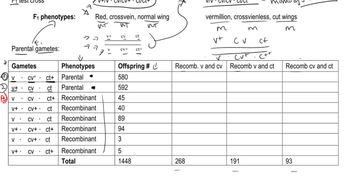Table of contents
- 1. Introduction to Genetics51m
- 2. Mendel's Laws of Inheritance3h 37m
- 3. Extensions to Mendelian Inheritance2h 41m
- 4. Genetic Mapping and Linkage2h 28m
- 5. Genetics of Bacteria and Viruses1h 21m
- 6. Chromosomal Variation1h 48m
- 7. DNA and Chromosome Structure56m
- 8. DNA Replication1h 10m
- 9. Mitosis and Meiosis1h 34m
- 10. Transcription1h 0m
- 11. Translation58m
- 12. Gene Regulation in Prokaryotes1h 19m
- 13. Gene Regulation in Eukaryotes44m
- 14. Genetic Control of Development44m
- 15. Genomes and Genomics1h 50m
- 16. Transposable Elements47m
- 17. Mutation, Repair, and Recombination1h 6m
- 18. Molecular Genetic Tools19m
- 19. Cancer Genetics29m
- 20. Quantitative Genetics1h 26m
- 21. Population Genetics50m
- 22. Evolutionary Genetics29m
4. Genetic Mapping and Linkage
Trihybrid Cross
Problem 26a
Textbook Question
Textbook QuestionThe following progeny are obtained from a test cross of a trihybrid wild-type plant to a plant with the recessive phenotypes compound leaves (c), intercalary leaflets (i), and green fruits (g). (Traits not listed are wild type.) The test-cross progeny are as follows:
Phenotype Number
Compound leaves 324
Compound leaves, intercalary leaflets 32
Compound leaves, green fruits 5
Compound leaves, intercalary leaflets, green fruits 51
Intercalary leaflets 3
Intercalary leaflets, green fruits 309
Green fruits 42
Wild type 49
815
How many double-crossover progeny are expected among the test-cross progeny? Calculate the interference for this cross.
 Verified Solution
Verified SolutionThis video solution was recommended by our tutors as helpful for the problem above
Video duration:
6mPlay a video:
Was this helpful?
Key Concepts
Here are the essential concepts you must grasp in order to answer the question correctly.
Test Cross
A test cross is a genetic cross between an individual with an unknown genotype and a homozygous recessive individual. This method helps determine the genotype of the unknown parent by analyzing the phenotypes of the offspring. In this scenario, the wild-type plant is crossed with a plant exhibiting recessive traits, allowing for the identification of the alleles present in the wild-type parent based on the phenotypic ratios of the progeny.
Recommended video:
Guided course

Trihybrid Cross
Crossover and Double Crossover
Crossover refers to the exchange of genetic material between homologous chromosomes during meiosis, leading to genetic variation. A double crossover occurs when two separate crossover events happen between the same pair of homologous chromosomes. Understanding these concepts is crucial for calculating the expected number of double-crossover progeny, as it involves analyzing the frequency of these events based on the observed phenotypes.
Recommended video:
Guided course

Double Strand Breaks
Interference
Interference is a phenomenon in genetics where the occurrence of one crossover event affects the likelihood of another crossover occurring nearby. It is quantified by the interference coefficient, which can be calculated using the formula: I = 1 - (observed double crossovers / expected double crossovers). This concept is essential for understanding the distribution of genetic recombination events and for calculating the interference in the given test cross scenario.
Recommended video:
Guided course

RNA Interference

 26:8m
26:8mWatch next
Master Trihybrid Cross with a bite sized video explanation from Kylia Goodner
Start learningRelated Videos
Related Practice

